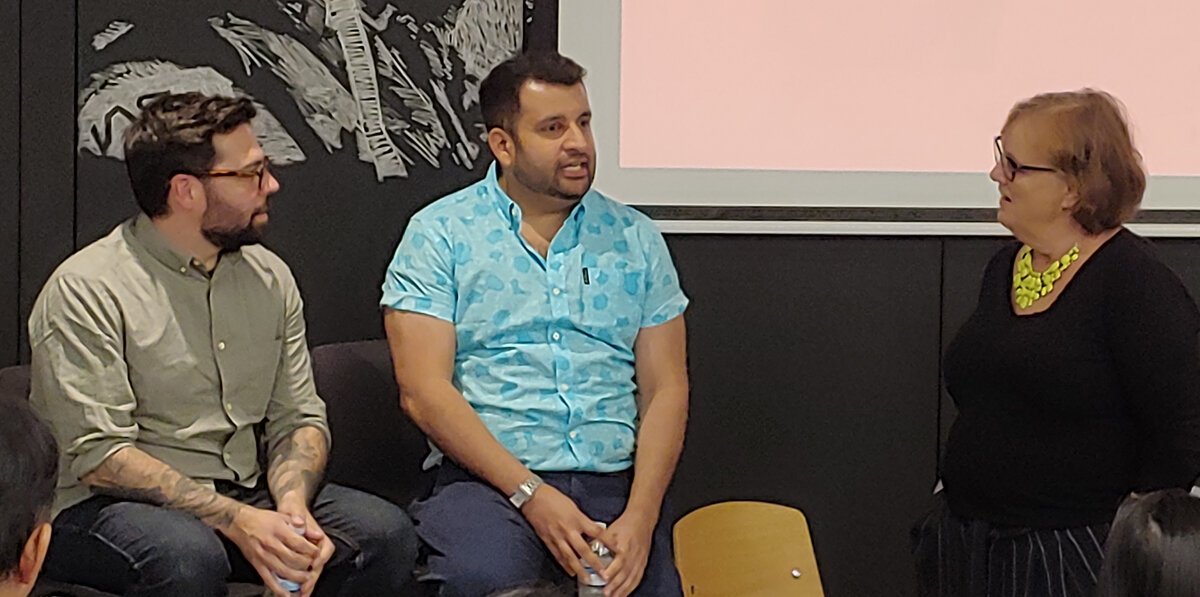How to Design to Get People Involved: Two startup founders use design thinking for civic impact
By Meghan Wenzel, UX researcher and strategist
Civic engagement and civic literacy are cornerstones of a healthy society. Unfortunately, it’s a lot more fun to contemplate our next Netflix binges than to focus on complex policy issues. I recently attended a really great event where Karen Borchgrevink, Executive Director of LA Tech4Good, moderated a lively discussion with Amit Thakkar, Founder and CEO of LawMaker, and Aaron Lyles, Founder and CEO of CommonAlly. Amit and Aaron discussed how they’re using thoughtful design and technology to address these extensive societal problems.
As they spoke, I noticed how they’ve skillfully employed design thinking to help them tackle these complex and daunting problems and enact positive social change. First, they empathized with their community and worked to understand their community’s core needs. Next, they decided what specific part of the problem they wanted to focus on, and then developed possible ideas and solutions to test out and collect feedback on. Finally, they continuously iterated and adapted their products to respond to challenges as they arose.
Understand the problem you’re trying to solve
In order to address a problem, both Amit and Aaron needed to define and deeply understand it. To them, civic tech means any technology that encourages people to get more involved in the civic space: for example, voting, increased participation and engagement, or enhanced relationships between people and government.
Amit worked as a political journalist, lobbyist, and political consultant, and he learned firsthand how broken the political system is. “I didn’t know much, but I was getting paid a lot of money to advocate for people who had a lot of money.” He was paid to learn about complex topics and then teach politicians about them, but always in a way that was in the best interests of his clients. He was distressed by how much influence money had in politics, and it was clear that no one else in the tech space was getting involved to address this problem.
Aaron also had firsthand experience of fractured civic engagement. “I was watching my family get torn apart over politics after the 2016 election.” He explained how his family had always been interested in politics, and they didn’t agree on many things, but they could always get along. That was until 2016. He also was concerned by disengagement — a lack of passion and activation — in young people, the biggest voting block. He quit his job at a fintech company, where he created content to teach people how to save and invest, and he focused on using his skills to increase civic engagement through concise, authentic, and digestible educational content.
Determine a focus area, explore ideas, and create solutions
Based on his experience and understanding of the problem, Amit decided to focus on educating people and encouraging legislative change. He began building an app called Politi-Score that notified users when new legislation in their community was introduced. He provided a summary of the legislation, ways to learn more, a general legislative schedule, and actions users could take to impact the legislation.
He began with an MVP and tested it with 1,600 people. “We heard shocking news — people loved it! They said it was designed well and provided good information that they could use, however 88% wouldn’t use it because they felt like they couldn’t make any difference in the political world once they spent time educating themselves on the app. We heard things like ‘Why spend one hour learning about Iraq, when I can’t make a difference?’ or ‘My vote just doesn’t matter.’”
Ultimately, people wanted to engage and feel like they could make a difference. From this early feedback, he pivoted to building a micro-lobbying platform called LawMaker that made it easier for people to engage. Through the web platform, users can create new policy ideas and share them on Facebook, Twitter, or other crowdsourcing platforms. Others can add amendments or up-vote the ideas, and then the idea owners can engage their politicians and start a conversation about the change they want to see.
Similar to Amit, Aaron decided to focus on educating people, encouraging dialogues, and turning passion into action. He sold his house, put together a product team, and went around his community to talk with people and collect feedback on his ideas. He wanted to understand the disengagement problem more deeply and learn about others’ perspectives and experiences.
Based on these discussions, he decided to focus on building engaging non-partisan content that relates to people on a genuine and digestible level. He removes opinion and objectively explains a topic or issue. “Instead of writing an article around should Trump get impeached, I’ll write about the impeachment process and make sure users understand its five steps.” He also includes how users can take action, get involved, and help solve problems within each content piece.
Define and measure success
After understanding the problem more deeply and focusing in on a specific solution, Amit and Aaron had to conceptualize success and hold themselves accountable.
Amit defined success by increasing social impact and engagement. He operationalized this by measuring how many times people share their LawMaker policy directly with elected officials as well as how many new policies are created on LawMaker after a major political event.
Aaron defined success as increased education and engagement in politics. He operationalized this by measuring content views and the number of people registering to vote via the CommonAlly app.
Iterate and adapt to address challenges
Of course, Amit and Aaron still face challenges and have to iterate and refine their approach. Both discussed key challenges they’re facing — fundraising, establishing trust and legitimacy, and maintaining engagement — and how they’ve begun addressing them.
Fundraising:
Both Amit and Aaron noted that securing funding has been a big challenge. Amit pitched several venture capitalists and angel investors before LawMaker launched, but they wanted revenue and a larger user base before they’d invest. In response, Amit decided to keep his day job and work on LawMaker as a second full-time job. Additionally, he explored crowdfunding opportunities and had success with two different crowdfunding campaigns.
Trust and legitimacy:
“Why should I trust LawMaker?” “I want this idea to get off the ground, but I can’t get people to trust LawMaker, a platform they’ve never heard of before,” “How do I know you won’t use our data for bad?” are all concerns Amit has heard.
In response, Amit launched LawMaker Challenges. LawMaker partnered with elected officials and challenged constituents to come up with policy ideas. The elected officials committed to taking political action on the ideas that got the most votes on the platform. A local scientific researcher named Jamie Tijerina proposed holding more Los Angeles City Council meetings outside the typical 9-to-5 workday, so more constituents could get involved. This non-partisan and easy-to-understand measure received the most votes, so Councilman David Ryu introduced Tijerina’s winning policy idea as a motion before the Los Angeles City Council. This challenge was a great way to demonstrate to skeptics how LawMaker users can directly impact legislation.
CommonAlly has also taken measures to gain trust and legitimacy. Aaron explained how data ownership is really important in establishing and maintaining trust. CommonAlly ensures that their users own and control all of their own data, and users appreciate this transparency. Additionally, CommonAlly regularly meets with people on both sides of the aisle and establishes partnerships with local leaders, who then evangelize CommonAlly to their followers and build the organization’s legitimacy.
Engagement:
“Will it make a difference?” and “Will anything come out of it?” are also common concerns. Amit notes, “Time is valuable, and many people would rather watch Friends again than watch a video for 27 minutes and then have nothing come out of it.” LawMaker’s Challenges help address this issue. By demonstrating clear and concrete legislative impact, their users are more motivated and inspired. Aaron also noted that a successful part of CommonAlly’s platform is gamification and incentives aimed at increasing engagement and education.
What can people do?
To round out the night, the speakers were asked what action we can take right now. Aaron implored us to find the humanity in others and start a dialogue with people you disagree with.
Amit challenged us to encourage people creating good information out there and disincentivize people putting out bad information. “Get subscriptions, pay for good journalism, and be careful with your clicks! If you click on bad stories, you’re telling news outlets you like or care about these. We need to elevate ourselves and realize that our microinteractions matter.”
He also pushed gateway activism, the concept that small steps incentivize you to take bigger steps later on. “Don’t think small civic action is too little. Participating in something like a women’s march wires your brain to pay attention to that issue more and take further action later on.” And finally, he urged everyone to “Vote, vote, vote! Vote local, state, and federal, and tell people younger than you to vote.”
I found this discussion to be an excellent case study in using thoughtful design and design thinking to promote civic engagement and social good. It was inspiring to hear these founders’ stories and learn about how they empathized and identified a problem in their community, defined the scope and focus of their solution, prototyped and collected feedback, and iterated and refined their approach as needed. They focused on understanding the key barrier to civic engagement — a feeling of being powerless or overwhelmed — and designed a way to overcome it. These examples illustrate how thoughtful design can usher in major changes.
About the author
Meghan Wenzel is a UX researcher and strategist and LA Tech4Good volunteer, and offers some insights from our Civic Tech panel on using design thinking in politics, reprinted from Modus, a Medium publication about UX/UI design, here.


